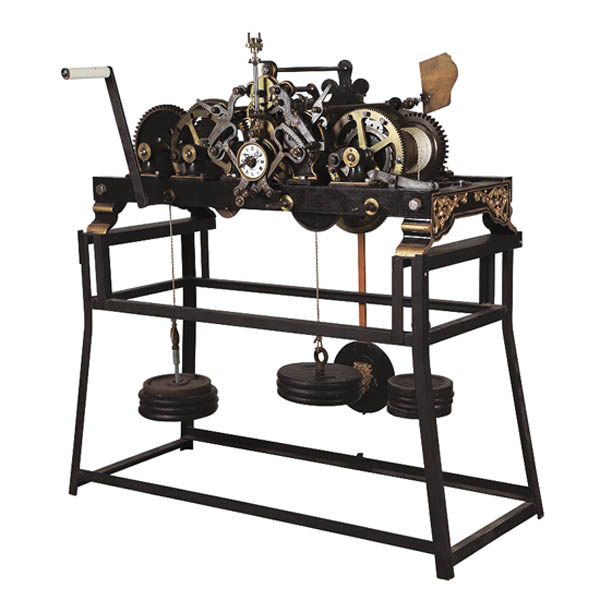Canadian Antique Clocks Excel At Miller & Miller Sale
Music Machines, Stoneware, Advertising And Trade Signs, Toys, Breweriana, Paintings Rounded Out Offerings
The 646-lot auction featured four outstanding collections: the Cathy and Gerry Koolen collection of Dutch clocks, tower clocks and music machines; the Robert Russell collection of Canadian Pequegnat clocks; the John Wine collection of fine Canadian furniture; and the Ben Lennox collection of rare, fresh-to-market items ranging from early historic trade signs to rare seltzers.
Top lot honors went to a French Paul ODobey wire tower clock made in 1899 and restored in 2007. The clock featured a three-train rack, snail strike mechanism and pinwheel remontoire. It originally came from a monastery and featured an angelus strike, striking 12 times on a small bell to signal the monks to prayer three times a day. The clock changed hands for $11,800.
Two clocks each posted prices of $7,080. One was a Nathan Hale banjo clock made in Vermont in 1840. The eight-day, time only clock had a movement similar to Willard, with tabs on the corners. The other was an English William Potts & Sons tower clock from 1899, with gravity escapement, original dial and elecrto-wind (no modification to movement, manual wind intact).
In addition to clocks, Canadiana and music machines, the catalog also boasted pottery and stoneware, folk art, advertising and trade signs, toys, breweriana, paintings, fine art and more. A collection of game pie dishes, 16 dishes in all, by makers that included Gerbing & Stephan, Wedgwood, Staffordshire and George Skey, brought a combined $12,744 for the collection.
A game pie dish is just an old piece of pottery until someone knows that these unglazed dishes were intended to emulate pastry during the flour shortages of the early 19th century, said Ethan Miller of Miller & Miller Auctions Ltd. The collection brought twice what we had expected.
Miller said the American-made Birge & Fuller Wagon Spring clock from the 1840s was another object that told a story and brought high dollars as a result. The maker wanted the benefits of a compact brass spring driven movement without those clunky weights, he said. Unlike in Europe, the brass springs were not available. A patented wagon spring fusée style movement was the compromise. American ingenuity at its finest. It ended up bringing $3,540.
Miller remarked, however, that not all the news coming out of the sale was good. Canadian furniture and wooden trade signs performed well, but we saw evidence that the market for clocks overall is down, he said. Though Koolen tower clocks exceeded all estimates, the Pequegnat clocks fell short in many cases. Advertising remained red-hot, while signs shattered estimates.
A Wurlitzer Model 147 military band organ, made in America in 1916, very rare and including an assortment of Style 150 music rolls, finished at $5,605. The Wurlitzer Band Organ sold well under estimate, remarked Miller. This thundering crowd-pleaser has all of the bells and whistles. It might have performed better before outdoor gatherings for parades were cancelled.
In the Canadian furniture category, a Drumbo (Ontario) painted pine sawbuck table from the 1830s, pictured in Howard Pains book, The Heritage of Upper Canadian Furniture, realized $7,080, while an 1830s Quebec one-door commode, of full mortise and tenon construction and having paneled sides and door, diminutive at 38.5 inches tall by 32 inches wide, brought $5,605.
A Wellesley (Ontario) painted pine Schrank wardrobe made from painted pine in the 1850s, featuring a subtle fern motif in the door panels and impressive at 89 inches tall by 63.5 inches wide, achieved $5,605. Also, a Canadian Niagara Falls Railway Suspension Bridge wood sign from the 1880s (Travel over and back for 10 cents), 50.5 inches in width, went for $4,720.
Clocks from Canada included a Pequegnat Barley Twist variant hall clock from the 1920s housed in a quarter sawn oak case and featuring eight-day weight-driven time and strike movement ($4,720), and a 1930s Pepsi-Cola neon clock made exclusively for the French-Canadian market, with a handpainted dial featuring Pepsis early double-dot logo and lighted dial ($4,425).
An early 20th century Seth Thomas No. 2 railway clock in a walnut case, reportedly from the Grand Trunk Railway station in Stratford, Ontario, Canada, but made in the U.S., commanded $3,540. On to Dutch clocks, where a B. Eijsbouts tower clock made in 1905 for a church in Meliskerke, The Netherlands, cast steel with brass pinions, 40 inches tall, realized $4,720. A Dutch Zaanske Klok wall clock, made between 1690-1725, in a walnut case with barley twist columns, rope drive time, strike and alarm, crown wheel escapement and heart-shaped spokes, rose to $3,835. Also, a Dutch animated tall case Klok clock made in Amsterdam in 1770, 110 inches tall, with plated movement, quarter striking, moon dial and date aperture, made $5,900.
For more information, call 519-573-3710 or visit www.MillerandMillerAuctions.com.












